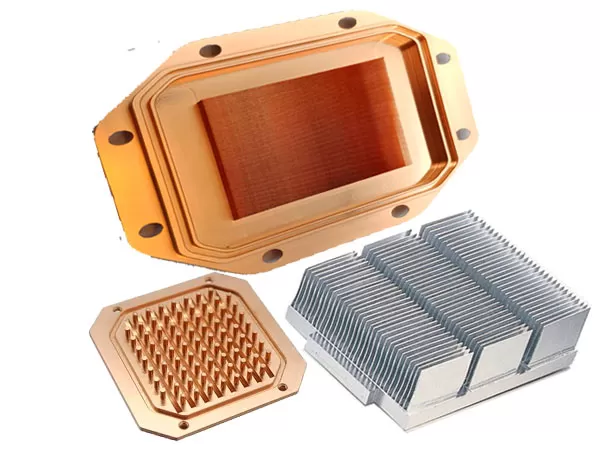
1. Heat sink design
Skived fin structure design
Fin shape and size: The shape of the tooth is usually trapezoidal or rectangular, and its parameters such as height, thickness and spacing need to be optimized according to the specific heat dissipation needs and equipment space. In general, higher teeth can increase the heat dissipation area, but will increase air resistance; Thinner teeth allow for good air circulation, but may reduce heat dissipation efficiency. Therefore, there is a need to strike a balance between the two.
Fin spacing: Reasonable tooth spacing ensures that the air flows fully inside the radiator and takes away the heat. Too small tooth spacing will lead to poor air flow and thermal resistance; If the tooth spacing is too large, the heat dissipation area will be reduced. In general, a tooth spacing between 2 and 5 mm is appropriate, and the exact value can be determined by thermal simulation analysis and actual testing.
Heatsink fin layout
Fin arrangement: Common fin arrangement methods include parallel arrangement, staggered arrangement and louvered arrangement. The parallel arrangement structure is simple and easy to manufacture, but the air flow resistance is relatively large; Staggered arrangement can improve air flow and heat dissipation efficiency, but the manufacturing process is relatively complex. The louvered arrangement can guide the air to form turbulence while increasing the heat dissipation area, which further enhances the heat dissipation effect, but the cost is higher. According to different application scenarios and heat dissipation requirements, select the appropriate fin arrangement.
Fin height and thickness: The height and thickness of the fins directly affect the heat dissipation area and air resistance. Increasing the height of the fins can increase the heat dissipation area, but it will increase the air flow resistance and the load of the fan. Reducing the fin thickness can reduce air resistance, but may affect the strength and heat dissipation performance of the fins. Therefore, it is necessary to consider these factors in the design process and find the optimal combination of fin height and thickness by optimizing the design.
2. Manufacturing process
Skived fin processing technology
Cutting: The traditional skived fin processing method uses a cutting process to process the raw material into the desired shovel tooth shape through equipment such as a lathe or milling machine. This method has high machining accuracy, but low efficiency, and is suitable for small batch production or occasions that require extremely high precision.
Extrusion: The extrusion process is an efficient method of manufacturing skived fin by extruding a heated metal blank in a mold to form multiple skived fin at once. This process has the advantages of high production efficiency, low cost, and stable product quality, and is suitable for mass production. In the extrusion process, parameters such as extrusion speed, temperature and pressure need to be reasonably controlled to ensure the shape and dimensional accuracy of the skived fin.
Surface treatment process
Anodizing: Anodizing is a commonly used surface treatment method, which can form a dense oxide film on the surface of the heat sink, improve the corrosion resistance and surface hardness of the radiator, and also improve the heat dissipation performance of the heat sink. The thickness of the anodized film is generally between 5 - 20μm, which can be adjusted according to actual needs.
Electrophoretic coating: Electrophoretic coating is a coating method in which paint particles are deposited on the surface of a radiator under the action of an electric field. This method has the advantages of uniform coating, strong adhesion and good corrosion resistance, and can provide good appearance protection and decorative effect for the radiator. Coating thicknesses for electrophoretic coatings are typically between 10 and 30 μm, which can be selected according to different color and performance requirements.
3. Material selection
Substrate material
Aluminum alloy: Aluminum alloy is a commonly used base material for air cooled skived fin heat sinks, which has the advantages of low density, high thermal conductivity and good processing performance. Common aluminum alloy grades are 6063, 6061, etc., among which 6063 aluminum alloy has good extrusion performance and is suitable for manufacturing shovel tooth radiators; 6061 aluminum alloy has high strength and hardness, and is suitable for some occasions with high requirements for structural strength.
Copper: Copper has a higher thermal conductivity than aluminum alloys, but it is denser and more expensive. Therefore, copper is often used in some high-end equipment or special occasions that require extremely high heat dissipation performance. In practical application, in order to reduce the cost and weight, the base material of copper-aluminum composite is sometimes used, that is, the copper sheet or copper tube is inlaid on the aluminum alloy matrix to improve the local heat dissipation capacity of the heat sink.


 +86-18902844286
+86-18902844286
 E-mail
E-mail
